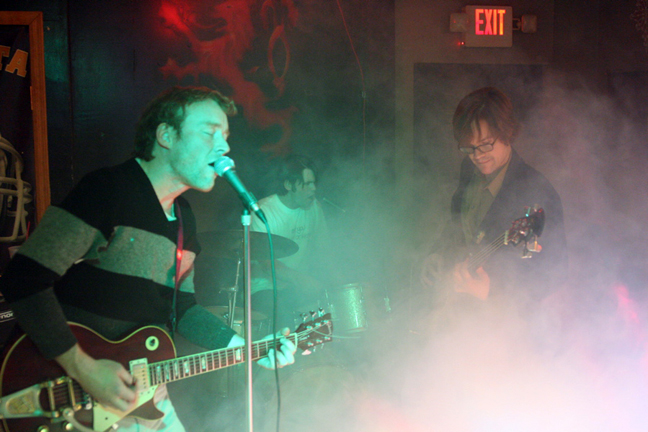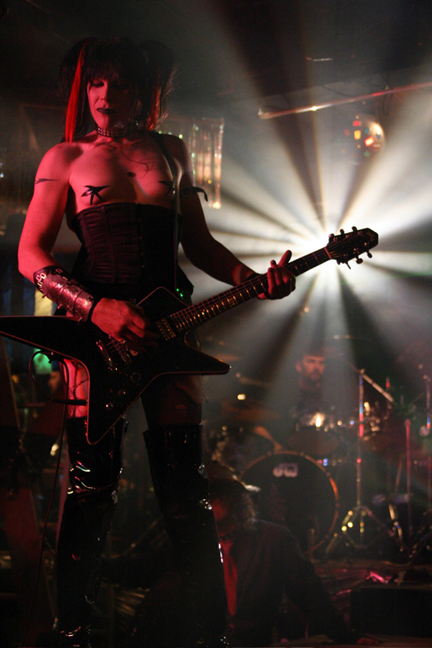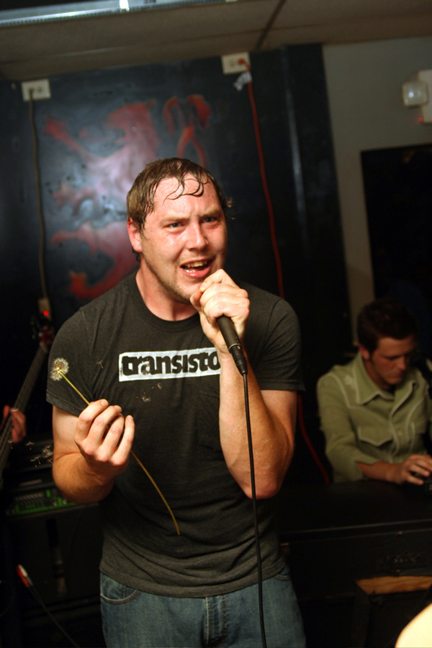Jimi Sides: You Can’t Do Everything, But You Can Try
Chris Godsey spoke to music photographer Jimi Sides about his frenetic life as photographer, music fan, videographer, zine publisher, and human being.




Every artist should have the emotional courage Duluth photographer Jimi Sides has: he’s not afraid to cry, sound crazy, come off as arrogant, or otherwise be an honest human being, even during an interview for publication.
He’s a bit unstable, self-aware enough to be self-centered, and maybe a little self-destructive, and in a two-hour conversation at the Duluth Athletic Club Deli, he hid none of those characteristics. (He also didn’t hide his remarkable sweetness, appreciation for opportunity, and desire to keep expanding his perspective of the world and himself.)
Also: like any good artist, he uses that navel-gazing and self-knowledge to come up with creative observations about human existence. And that’s art distilled to its most basic purpose: to reflecting, interpreting, and negotiating some aspect of being human.
Sides, who’s 26, works his ass off creating his own stuff, promoting and interpreting other artists, and seeking some sort of enlightened understanding of who he is, what his purpose is, and how he and his fellow human beings fit together.
He also delivers Pizza Luce pies and operates a TV camera, jobs no less tough or significant than all that stuff in those previous paragraphs.
Most people who know of Sides got familiar with him through his live music photography (excellent examples are at http://www.jimisides.com). He claims there’s no art to what he does:
“Photos can be fine art,” he says, “but what I do is shooting fish in a barrel. I like to go to concerts, and I take my camera when I go to them. It’s like laying bricks. I approach it like a trade. If you get a camera and keep laying those bricks, soon you’ll learn an lot and become proficient and have good products.”
Sides’ formative photography experiences are both typical–snapping photos at family gatherings–and not–taking pictures out the window of his dad’s semi rig as a preschooler.
“I remember taking photos,” he says, “but I don’t remember ever getting prints back. My dad had this hibachi grill, and he’d cook SPAM or corned beef hash or whatever, and I have a very clear memory of taking a photo of him doing that.”
Till “seventh or eighth grade,” he was a casual shutterbug. Then he had an epiphany: “We had a job shadowing day,” he says. “My dad wasn’t in my life by then, and I didn’t want to go to my mom’s job [teaching second grade], so I contacted the St. Cloud Times, and followed a guy named Mike Knack.
“The day I was with him, some kid shot his sister in the mouth, and we went to the press conference. We went to a St. Cloud State hockey game, and he showed me all kinds of tricks. Then he left me with another Times photographer named Kim Anderson, who was one of the first guys shooting digital, and he showed me some incredible PhotoShop stuff and the AP computer system. it was an incredible experience for a visual person like me.”
He decided to become a serious photographer. In ninth grade, he carried his mom’s point-and-shoot a lot. He left it in his school locker one night, and it got stolen.
“I drained a savings account that had five or six hundred dollars in it,” Sides says. “Money my grandpa had given me five or ten bucks at a time since I was pretty little. Then I bought a Canon Rebel SLR at Best Buy. I lied to my mom and told her I traded her camera for the Canon at a pawnshop. At the time I thought she’d believe it.
“And then I felt obligated to use the camera, out of respect for my grandpa, because the money was supposed to be for flying lessons. I thought, ‘I’m gonna use the hell out of this thing and find out what it’s all about.’ I’m an only kid, so I became friends with technology. I still obsessively read instruction manuals.”
After high school stints at St. Cloud Apollo and Tech (where he got deep black-and-white and color darkroom experiences), and at the Perpich Center for Arts Education, Sides found himself at UMD.
“I hated my first year here,” he says. “I didn’t know the city.”
He made some friends and muddled through, eventually earning a design degree. Then, as happens with many curious, intelligent people, his real education started once he left school.
“I started dating Nikki Moeller,” a Pizza Luce manager and the bassist in well-regarded Duluth bands The Keep Aways and Boy Girl Boy Girl. “I took my camera to my first Boy Girl Boy Girl show on Nov. 23 2003, and it’s been pretty constant since then. I went to more and more shows, and I developed a sense of regret if the camera wasn’t along.”
He used to shoot exclusively film, gradually transitioned into all digital (“I’d rather sit in front of a Mac than be in a darkroom any day,” he says), and has been using experience–learning where to stand, how to compose, when to shoot–as a tool for taking fewer photos. Still, he estimates he’s saved more than 35,000 high-resolution photos in the last three years. He’s taken close to 100,000.
“With documentation, once you start, it’s tough not to be involved. Especially with bands like the Keep Aways, I’ve got so many photos, from so many shows, that it seems like there wouldn’t be any point to stopping.”
He says he’d be “nothing” if he hadn’t become close with Moeller.
“Dating Nikki was like having a sage guide, because she knows so many people. I knew nothing–I didn’t even know who Low was–and she taught me who was who, who was and used to be in what band with which people.”
Now his MySpace page lists 423 friends, many of them musicians.
He took photos at the 2005 CMJ showcase in New York City. “I went to New York and saw all Minnesota bands,” he says with a proud, self-deprecating laugh. “Atmosphere at the Bowery Ballroom. The Keep Aways at Lit Lounge. Retribution Gospel Choir.
“I got to shoot the Hold Steady at CBGB. They’re technically a New York band now, but they still feel like they’re from Minnesota. To be at CBGB is cool; to shoot there is awesome. I was wearing a Twins hat, and a shirt that said Minnesota in the shape of the Metallica logo. Craig Finn kept pointing at me. I got to talk to him after the show, then they played Luce a month later, and I sort of awkwardly handed him a bunch of photos I’d taken in New York.”
On the day we chatted, March 20, the Seattle label Sub Pop released Low’s Drums and Guns, whose packaging features 18 Sides photos of actual drums and guns. The gun shots were taken at a Duluth pawn shop, against grungy, red industrial carpet, and they’re masterpieces of subtle, simple menace.
He’s been publishing his own monthly (for the most part) ‘zine, High Plains Drifter, and organizing concerts for the release of each issue, since October 2006. He books artists, coordinates openings, and curates displays, and does deliveries at Pizza Luce. He’s a news videographer at Duluth’s FOX 21 TV station. He takes a lot of non-music photos on his own, and for the University of Minnesota Duluth Theater Department. And if he seems sleep-deprived and a bit nutty when you see him, he acknowledges your perception, even if he doesn’t directly say so.
“Life is so fucking short,” he says while rubbing eyes red with exhaustion and the tears of a few minutes prior, when he described why he broke up with Moeller (he didn’t like how dependent on her he’d become, or how she seemed to be taking care of other people more than herself), and how much he misses her (enough to cry in front of a stranger, in public), and the stress of dealing with a sick mom, a dad in prison, and the general struggle of living an artistic, viscerally examined life.
“You can’t do everything,” he says. “I’m coming to that conclusion. I would like time to do some other stuff–like maybe just take a walk. I don’t think too much into the future. I can’t. I take one day at a time, and try to do my best.”